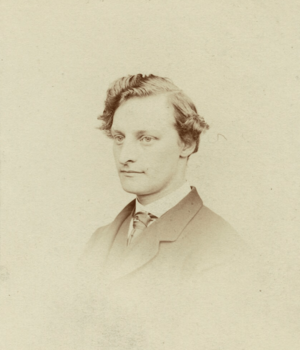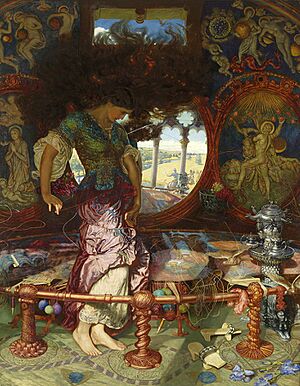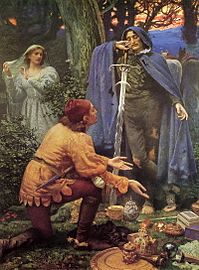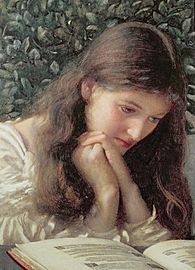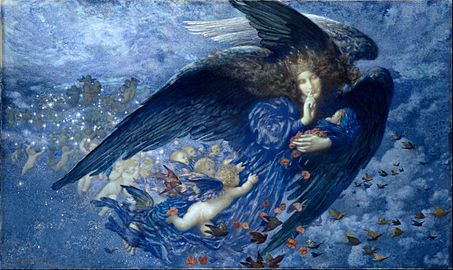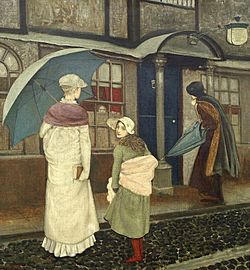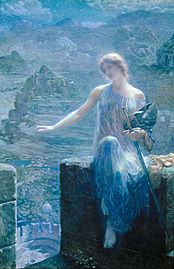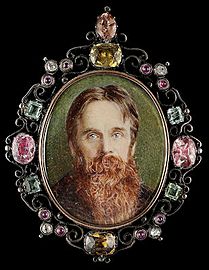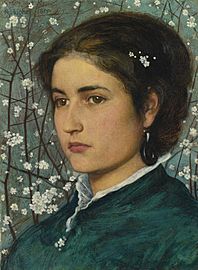Edward Robert Hughes facts for kids
Edward Robert Hughes (born November 5, 1851 – died April 23, 1914) was a British artist. He was known for his beautiful paintings, especially those made with watercolours. He also created some oil paintings. Edward was inspired by his uncle, Arthur Hughes, who was part of a famous art group called the Pre-Raphaelite Brotherhood. Edward also worked closely with William Holman Hunt, one of the founders of this group.
Contents
Becoming an Artist
Edward Robert Hughes decided early on that he wanted to be an artist. He went to Heatherley's art school in London. This helped him get ready to join the Royal Academy Schools in 1868.
His art was greatly shaped by the ideas of the Pre-Raphaelite Brotherhood. This group of artists liked bright colors and detailed scenes. They often painted stories from history or literature. Edward's paintings also showed Aestheticism, which focused on beauty for its own sake.
Famous Paintings
Edward Robert Hughes is most famous for his amazing and imaginative watercolour paintings. Some of his well-known works include Midsummer Eve and Night with her Train of Stars.
But when he first started, he painted many portraits of wealthy people.
Working with William Holman Hunt
Besides being an artist himself, Edward Hughes also helped an older artist named William Holman Hunt. Hunt was one of the original members of the Pre-Raphaelite Brotherhood. Later in his life, Hunt had problems with his eyesight. Edward Hughes helped him finish many of his paintings.
Two of the famous paintings Edward helped Hunt with were The Light of the World and The Lady of Shalott. The Light of the World can be seen in St Paul's Cathedral in London. The Lady of Shalott is displayed at the Wadsworth Atheneum art museum.
Edward was very careful with his own art. He often made many practice drawings for his paintings. Some of these practice drawings were so good that they were put on display too!
Art Community Involvement
Edward Hughes was an important part of the art world during his lifetime. He joined the Art Workers Guild in 1888. He was also elected to the Royal Watercolour Society (RWS) in 1891. This is a group for artists who specialize in watercolour painting.
For his full membership, he submitted a mystical painting called Oh, What's That in the Hollow?. This painting was inspired by a poem by Christina Rossetti. One of his paintings, A Witch, was given to King Edward VII and Queen Alexandra for their coronation in 1902. Later, Edward Hughes became the Vice-President of the RWS.
Edward Hughes showed his art in many galleries in London. These included the Dudley Gallery, Grosvenor Gallery, and the Royal Academy.
Today, you can see his works in public art collections. Some of these are the Birmingham Museum and Art Gallery, the Ashmolean Museum in Oxford, and the Harris Museum & Art Gallery in Preston.
In 2015, the Birmingham Museums Trust held a special exhibition of his art. It was called Enchanted Dreams: The Pre-Raphaelite Art of E.R. Hughes.
His Life
Edward Robert Hughes was born in London in 1851. His family called him "Ted." He had a younger brother, William Arthur Hughes, who became a photographer. For a while, Edward lived with his uncle, Arthur Hughes, who was also an artist.
In 1874, Edward got engaged to Mary MacDonald. Sadly, Mary passed away four years later. In 1883, Edward married Emily Eliza Davies. They moved to St Albans in 1913. Edward died in 1914 after an operation. He and Emily did not have any children.
List of works
Gallery
See also


